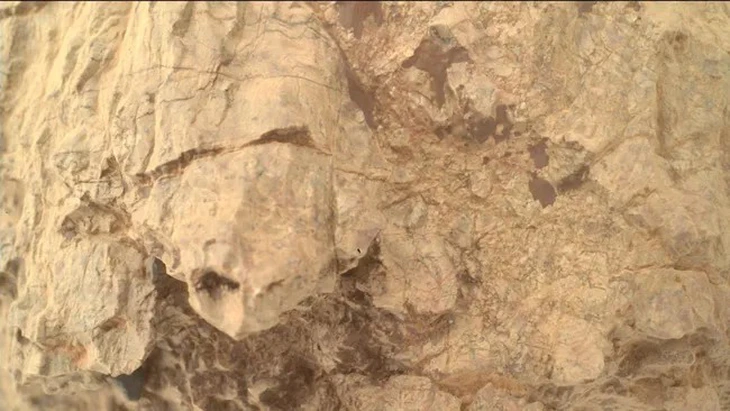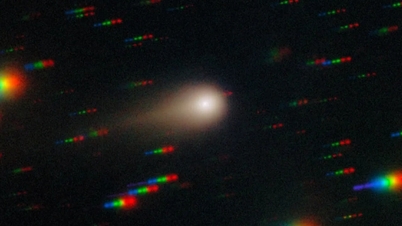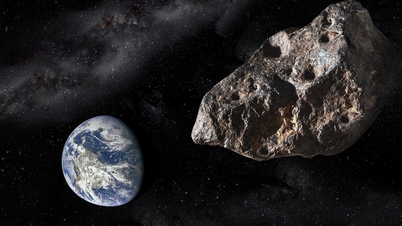
The photo of the turtle-shaped rock was taken on August 31, 2025 (the 1,610th Martian day of Perseverance's journey) at Jezero crater, an area about 45km in diameter, where scientists believe a giant lake once existed in the past - Photo: NASA
The stunning image of Mars was captured by two of Perseverance's advanced instruments: SHERLOC (Scanning Habitable Environments with Raman & Luminescence for Organics and Chemicals) and WATSON (Wide Angle Topographic Sensor for Operations and eNgineering). These two instruments combine to scan the surface of the rock in visible and ultraviolet light, capturing sharp images of its structure.
This particular rock has a protruding “head” with two eye-like holes, covered by a “shell” with two symmetrical “front legs” on either side. This shape makes many people think of a turtle moving on the surface of Mars.
However, it is still unclear what geological process created this special shape. Scientists think that the shape of the rock may have been naturally carved by ancient water flows that once flowed through Jezero Crater, or by strong winds and dust storms on Mars over millions of years.
The phenomenon of seeing familiar images in rocks, clouds or planetary surfaces is called pareidolia, a psychological phenomenon that causes people to associate random shapes with familiar objects on Earth.
This is not the first time Perseverance or other rovers have recorded "bizarre" images on Mars.
In the past, NASA rovers have discovered many rocks that resemble objects or creatures on Earth, such as human fingerprints, mysterious doors, small blueberries, "Star Trek" symbols, and even a rock that looks like a human "skull."
Notably, last August, Perseverance also recorded a rock shaped like a medieval helmet and before that in April, a strange rock that looked like a "skull" also caused a lot of controversy.
Additionally, orbiters around Mars have captured images of large geological structures that look like dogs lying under the North Pole, smiling cartoon teddy bears, and "swarms of spiders" that appear seasonally on the planet's surface.
While these findings are not proof of life, they provide important information about Mars' geological history and help scientists better understand how wind, water and time have shaped the planet's surface.
Source: https://tuoitre.vn/nasa-phat-hien-rua-tren-sao-hoa-20250910101837745.htm


![[Photo] Solemn opening of the 8th Congress of the Central Public Security Party Committee, term 2025-2030](https://vphoto.vietnam.vn/thumb/1200x675/vietnam/resource/IMAGE/2025/10/4/f3b00fb779f44979809441a4dac5c7df)


![[Photo] Bustling Mid-Autumn Festival at the Museum of Ethnology](https://vphoto.vietnam.vn/thumb/1200x675/vietnam/resource/IMAGE/2025/10/4/da8d5927734d4ca58e3eced14bc435a3)

![[Photo] General Secretary To Lam attends the 8th Congress of the Central Public Security Party Committee](https://vphoto.vietnam.vn/thumb/1200x675/vietnam/resource/IMAGE/2025/10/4/79fadf490f674dc483794f2d955f6045)


















































![[VIDEO] Summary of Petrovietnam's 50th Anniversary Ceremony](https://vphoto.vietnam.vn/thumb/402x226/vietnam/resource/IMAGE/2025/10/4/abe133bdb8114793a16d4fe3e5bd0f12)

![[VIDEO] GENERAL SECRETARY TO LAM AWARDS PETROVIETNAM 8 GOLDEN WORDS: "PIONEER - EXCELLENT - SUSTAINABLE - GLOBAL"](https://vphoto.vietnam.vn/thumb/402x226/vietnam/resource/IMAGE/2025/7/23/c2fdb48863e846cfa9fb8e6ea9cf44e7)

































Comment (0)